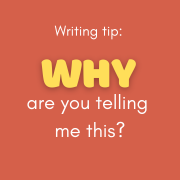Writing tip: Why are you telling me this?
“Why are you telling me this?” I ask this again and again as I read articles written by nonprofessional writers. Their articles don’t capture my attention because they don’t give me a reason to care about their topic.
Why nonprofessionals fall short
Nonprofessional writers display admirable enthusiasm for their topics, but they often have a hard time putting themselves in the “shoes” of their readers.
Nonprofessional writers often fail to answer the question, “What’s in it for me?” (WIIFM). Readers look for the WIIFM when they decide whether to read your article. If they’re reading online, they’re often looking for a solution to a specific problem they face. They’re not going to read your article just because you publish it on your blog or in your newsletter.
If people start reading your article because they have a relationship with you, they still want to learn the WIIFM, even if the answer is only “You’ll learn an interesting idea that you can share with your colleagues or on social media.”
Nonprofessional writers often suffer from the “curse of knowledge.” As I discussed in “Why hire a writer? Three powerful reasons,” it’s hard for them to explain things to outsiders because they know too much. They may use words that are too technical or they get bogged down in details. They can also forget to say why their topic is important because its importance is so clear to them.
Questions to help you
Here are two questions that can help you figure out why you are writing an article.
- How do you want this article to help you or your organization?
For example, are you writing an article to gain new newsletter subscribers or to interest readers in a specific product or services offered by your company? Do you want to correct a misconception about your company being too conservative (or too aggressive), or not up on the latest investments, or not well-run?
You may not explicitly mention this goal in your article. However, understanding this goal will help to shape your article. And, your article may benefit from an explicit call to action, such as “For more tips, subscribe to our newsletter!” or “Schedule a call to learn about our XYZ service!”
- What’s the WIIFM for your readers?
What is a problem that your readers face that your article can solve? It could be something specific to your firm, such as how to explain to their bosses why they’re sticking with your firm instead of switching to a firm with a better-known name. Or maybe it’s solving a challenge with their organization’s budgeting, or the need to have something interesting to discuss at their next social event.
I explain a way to identify your reader’s WIIFM in “Identifying ‘WHAT PROBLEM does this blog post solve for them?’”
Tell readers why you’re telling them
Once you’ve figured out your reader’s WIIFM, don’t forget to incorporate it into your article. Don’t phrase it as “I’m telling you this because.” Instead, identify the reader’s pain point, and say how your article addresses it.
I share one way to do this in “Make your writing easier with my fill-in-the-blanks approach for structuring articles.”






